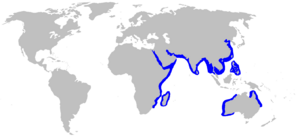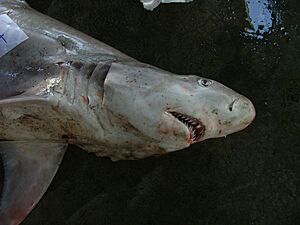Snaggletooth shark facts for kids
Quick facts for kids Snaggletooth shark |
|
|---|---|
 |
|
| Conservation status | |
| Scientific classification | |
| Genus: |
Hemipristis
|
| Species: |
elongata
|
 |
|
| Range of the snaggletooth shark | |
The snaggletooth shark, also sometimes called the fossil shark (Hemipristis elongata), is a type of weasel shark. It's the only living member of its group, called Hemipristis. You can find this shark in the Indo-Pacific region. This area stretches from southeast Africa all the way to the Philippines, north to China, and south to Australia.
Snaggletooth sharks usually live in coastal waters, close to the bottom. They can be found at depths from 1 to 130 meters (about 3 to 426 feet). These sharks can grow up to 240 centimeters (almost 8 feet) long. Even though they are considered "vulnerable" to extinction, they are not seen very often.
Contents
What Does the Snaggletooth Shark Look Like?
The snaggletooth shark is usually light grey or bronze. It does not have any special markings on its body. As its name suggests, it has very sharp teeth. The teeth on its upper jaw are serrated, meaning they have saw-like edges. The teeth on its bottom jaw are hooked.
The shark's body shape is called fusiform. This means it's shaped like a torpedo, which helps it swim very fast in the water.
How Do Snaggletooth Sharks Reproduce?
Snaggletooth sharks have a special way of giving birth. It's called placental viviparity. This means the mother shark carries her live young inside her body. The young sharks grow inside a structure that works a bit like a placenta, complete with an umbilical cord. This structure helps the baby sharks get nutrients from their mother.
What Do Snaggletooth Sharks Eat?
The snaggletooth shark eats many different kinds of animals. Its diet includes bony fish, other sharks, and rays. They also hunt crabs and cephalopods, which are animals like squid and octopuses.
Why Are Snaggletooth Sharks Fished?
These sharks are often caught by fishing trawlers, which are special fishing boats. They are also caught using gill nets, which are large nets that hang in the water.
Different parts of the snaggletooth shark are used for various things. Their fins are used in shark fin soup, which is a dish eaten in China and other Asian countries. The meat from the shark is sold for people to eat. The liver is used to get vitamins, and the rest of the shark's body is processed into fish meal. Fish meal is used as food for other animals.




